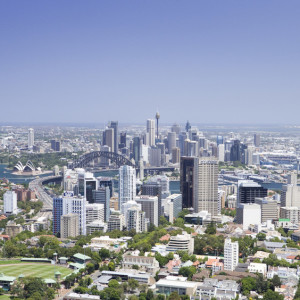The City of Sydney has identified opportunities to unlock almost 3 million square metres of development space, but claims it won’t be at the cost of urban liveability.
In its comprehensive urban planning strategy, the City of Sydney has recognised opportunities to develop up to 2.9 million square metres of additional floor space for retail, hotel, cultural and office needs to meet long-term targets for the city centre’s growth.
The draft of the Central Sydney Planning Strategy has identified concentrated ‘tower cluster’ areas where there is potential for 300 metre tall commercial buildings, subject to federal airport approval.
The pockets in which these ‘tower clusters’ are to be developed are reportedly situated to allow for the city centre to grow while still retaining essential solar access planes to Hyde Park and other important public areas such as the Royal Botanic Gardens, Martin Place and Wynyard Park.
Lord Mayor Clover Moore said the strategy provided certainty, consistency and continuity of planning to help the city more effectively encourage economic and employment growth over the next two decades.
“Past planning strategies have successfully increased the number of residential buildings in the city centre, but now we need to protect and increase the amount of productive floor space to maintain Sydney’s economic vitality and resilience,” she said.
“Central Sydney has limited capacity to grow north, west and east because of its natural geography and harbour surrounds, heritage and the growth of residential development, which limit potential future renewal and change of use to meet the needs of a changing society.
“Planning for growth requires clear policies and careful management to protect the opportunities to increase the new economy’s floor space needs from high-priced residential on larger scale sites.
The Lord Mayor said that these economic imperatives need to be balanced with the provision of social infrastructure and amenity, while also protecting our city’s heritage and public spaces to improve urban liveability.
“Ensuring infrastructure keeps pace with growth, in terms of transport, cultural and social institutions and affordable housing, will help keep our community strong and maintain our standards of living.
“We need to preserve and maintain what is positive and unique about our city, while reshaping its other attributes to meet the needs of tomorrow’s Central Sydney.”
The City’s Director of Planning, Development and Transport, Graham Jahn AM, said the City had received positive responses to the strategy from the NSW Premier, Minister for Planning, Department of Planning and Sydney Business Chamber.
“The strategy builds on the evident success of a truly mixed-use city centre and the transformational investment that different sectors can bring to the city with the right framework and settings,” he said.
“Overall, the city must be adaptable and able respond to global market changes while preserving its identity and what makes it so attractive.
“The strategy builds on what has worked, strengthens what we value, and identifies what can change while managing the side effects.”
The new Central Sydney Planning Strategy includes 10 key moves and nine aims for business and residential development, balanced with the changing needs of the growing number of workers, residents and visitors.
The 10 key moves include:
- The expansion of Central Sydney to reabsorb The Rocks, Darling Harbour, Ultimo (The Goods Line, Central Park and UTS) and Central Railway to Cleveland Street. Having a single consent authority and framework will make planning more consistent and reduce red tape and hurdles;
- The prioritisation of business floor space employment by expanding the city’s commercial core west to Barangaroo and south to Belmore Park;
- The management of small sites to consider wind, sunlight, public views and setbacks. The City wants to encourage owners of city buildings to talk to their neighbours about their combined development potential – done well, sites that are amalgamated can reach better development outcomes while preserving heritage character;
- Progressing plans for three new squares along George Street – at Circular Quay, Town Hall and Railway Square – to provide precincts that improve the liveability of the city centre;
- The strengthening of public open space, accessibility and connections to make moving around the city easier and more enjoyable for workers, residents and visitors;
- The promotion of design excellence by requiring all towers and major developments to go through a design competition process;
- Ensuring transport and social infrastructure keeps pace with growth, and that Sydney is inclusive of all members of society by the introduction of an affordable housing levy; and
- A move toward zero net energy for all buildings through sustainability incentives for floor space ratio bonuses and minimum NABERs standards for new office buildings.





